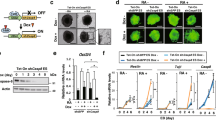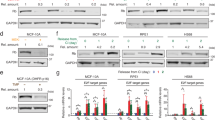Abstract
Zipper Protein Kinase (ZPK) is a leucine zipper protein localized to the nucleus which exhibits serine-threonine kinase activity and is associated with the stress dependent signal transduction pathway. ZPK forms heterodimers with leucine zipper containing transcription factors such as the cyclic AMP responsive element binding protein (CREB) and Myc. Furthermore ZPK phosphorylates both Myc and CREB. Overexpression of ZPK in NTera-2 human teratocarcinoma cells results in inhibition of PKA induced transcriptional activation by CREB and prevents retinoic acid induced differentiation of the cells to neurons. Our results suggest that ZPK stifles neural differentiation of NT-2 cells partly due to its inhibitory effect on CREB function.
This is a preview of subscription content, access via your institution
Access options
Subscribe to this journal
Receive 50 print issues and online access
$259.00 per year
only $5.18 per issue
Buy this article
- Purchase on Springer Link
- Instant access to full article PDF
Prices may be subject to local taxes which are calculated during checkout








Similar content being viewed by others
Abbreviations
- CREB:
-
cAMP response element binding protein
- ZPK:
-
zipper protein kinase
- CRE:
-
cAMP response element
- RA:
-
retinoic acid
- PKA:
-
protein kinase A
References
Abraham I, Sampson KE, Powers EA, Mayo JK, Ruff VA and Leach KL. . 1991 J. Neurol. Res. 28: 29–39.
Ausubel FM, Brent R, Kingston RE, Moore DD, Seidman IG, Smith JA and Struhl K. . 1996 In: Current Protocols in Molecular Biology. Vol.3. John Wiley Sons, Inc.
Brindle P, Linke S and Montminy M. . 1993 Nature (Lond.) 364: 821–824.
Cheung WMW, Chu AH, Leung M-F, Ip NY. . 1996 Neuroreport 7: 1204–1208.
Evans GI, Lewis GK, Ramsay G and Bishop VM. . 1985 Mol. Cell. Biol. 5: 3610–3616.
Fan G, Merritt SE, Kortenjann M, Shaw PE and Holzman LB. . 1996 J. Biol. Chem. 271: 24788–24793.
Gonzalez GA and Montminy MR. . 1989 Cell 59: 675–680.
Hagiwara M, Brindle P, Harootunian A, Armstrong R, River J, Vale W, Tsien R and Montminy MR. . 1993 Mol. Cell. Biol. 13: 4852–4859.
Hai T, Liu F, Coukos WJ and Green MR. . 1989 Genes Dev. 3: 2083.
Harlow E and Lane D. . 1988 In: Antibodies: A Laboratory Manual. Cold Spring Harbor Laboratory: Cold Spring Harbor, New York.
Hirai S-I, Izawa M, Osada S-I, Spyrou G and Ohno S. . 1996 Oncogene 12: 641–650.
Hirai S-I, Katoh M, Terada M, Kyriakis JM, Zon LI, Rana A, Avruch J and Ohno S. . 1997 J. Biol. Chem. 272: 15167–15173.
Holzman LB, Merritt SE and Fan G. . 1994 J. Biol. Chem. 269: 30808–30817.
Ikegaki N, Butovsky J and Kennett RH. . 1986 Proc. Natl. Acad. Sci. USA 83: 5929–5933.
Johnson PF and McKnight SL. . 1989 Ann. Rev. Biochem. 58: 799–839.
Kawai T, Matsumoto M, Takeda K, Sanjo H and Akira S. . 1998 Mol. Cell. Biol. 18: 1642–1651.
Lee KAW and Masson N. . 1993 Biochem. Biophys. Acta 1174: 221–233.
Liu F and Green MR. . 1990 Cell 61: 1217.
Martin KC and Kandel ER. . 1996 Neuron 17: 567–570.
Mata M, Merritt SE, Fan G, Yu GG and Holzman LB. . 1996 J. Biol. Chem. 271: 16888–16896.
Miller AD and Buttimore C. . 1986 Mol. Cell. Biol. 6: 2895–2902.
Mochly-Rosen D. . 1995 Science 268: 247–251.
O'Shea EK, Rutkowski R, Stafford III WF and Kim PS. . 1989 Science 245: 646–648.
Pleasure SJ, Page C and Lee VM-Y. . 1992 J. Neurosci 12: 1802–1815.
Reddy UR and Pleasure D. . 1994 Biochem. Biophys. Res. Comm. 202: 613–620.
Schrieber E, Matthias P, Muller MM and Schaffner W. . 1989 Nucl. Acid Res. 17: 6419.
Stockschlaeder MAR, Storb R, Osborne WRA and Miller DA. . 1991 Hum. Gene. Therapy 2: 33–39.
Sun P, Enslen H, Myung PS and Maurer R. . 1994 Genes Dev. 8: 2527–2539.
Wigler M, Pellicer A, Silverstein S and Axel R. . 1978 Cell 14: 725–731.
Acknowledgements
We thank Marge Williams for technical assistance with NT2 cell differentiation and Dr Montminy for providing the recombinant full length CREB. This work was supported in part by grants from the National Institute of Health (NS25044, NS08075, NS31102) and Muscular Dystrophy Association.
Author information
Authors and Affiliations
Rights and permissions
About this article
Cite this article
Reddy, U., Basu, A., Bannerman, P. et al. ZPK inhibits PKA induced transcriptional activation by CREB and blocks retinoic acid induced neuronal differentiation. Oncogene 18, 4474–4484 (1999). https://doi.org/10.1038/sj.onc.1202813
Received:
Revised:
Accepted:
Published:
Issue Date:
DOI: https://doi.org/10.1038/sj.onc.1202813
Keywords
This article is cited by
-
DLK
AfCS-Nature Molecule Pages (2009)
-
Inhibition of membrane depolarisation-induced transcriptional activity of cyclic AMP response element binding protein (CREB) by the dual-leucine-zipper-bearing kinase in a pancreatic islet beta cell line
Diabetologia (2006)



